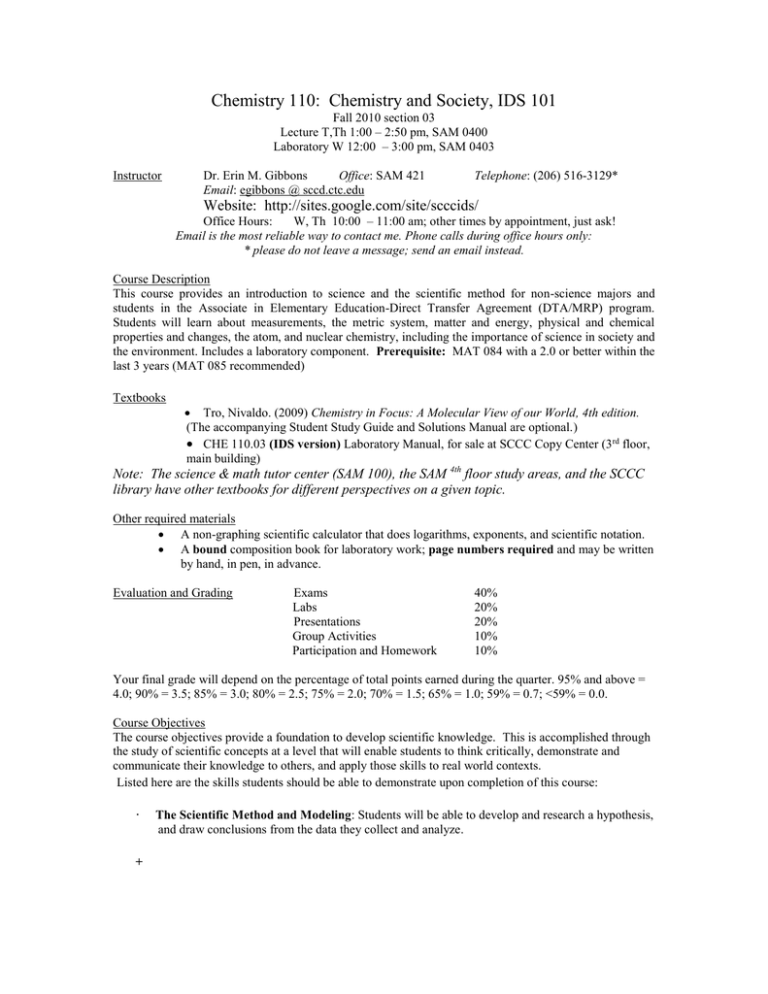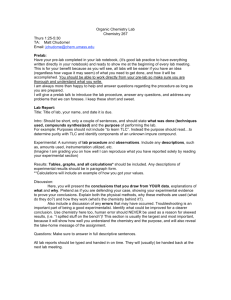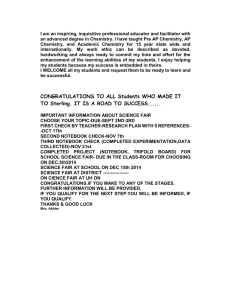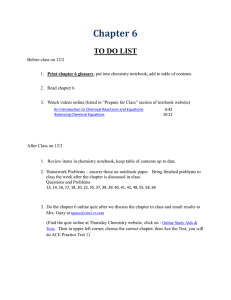Chemistry 110 -- Interdisciplinary Science 101
advertisement

Chemistry 110: Chemistry and Society, IDS 101 Fall 2010 section 03 Lecture T,Th 1:00 – 2:50 pm, SAM 0400 Laboratory W 12:00 – 3:00 pm, SAM 0403 Instructor Dr. Erin M. Gibbons Office: SAM 421 Email: egibbons @ sccd.ctc.edu Telephone: (206) 516-3129* Website: http://sites.google.com/site/scccids/ Office Hours: W, Th 10:00 – 11:00 am; other times by appointment, just ask! Email is the most reliable way to contact me. Phone calls during office hours only: * please do not leave a message; send an email instead. Course Description This course provides an introduction to science and the scientific method for non-science majors and students in the Associate in Elementary Education-Direct Transfer Agreement (DTA/MRP) program. Students will learn about measurements, the metric system, matter and energy, physical and chemical properties and changes, the atom, and nuclear chemistry, including the importance of science in society and the environment. Includes a laboratory component. Prerequisite: MAT 084 with a 2.0 or better within the last 3 years (MAT 085 recommended) Textbooks Tro, Nivaldo. (2009) Chemistry in Focus: A Molecular View of our World, 4th edition. (The accompanying Student Study Guide and Solutions Manual are optional.) CHE 110.03 (IDS version) Laboratory Manual, for sale at SCCC Copy Center (3 rd floor, main building) Note: The science & math tutor center (SAM 100), the SAM 4th floor study areas, and the SCCC library have other textbooks for different perspectives on a given topic. Other required materials A non-graphing scientific calculator that does logarithms, exponents, and scientific notation. A bound composition book for laboratory work; page numbers required and may be written by hand, in pen, in advance. Evaluation and Grading Exams Labs Presentations Group Activities Participation and Homework 40% 20% 20% 10% 10% Your final grade will depend on the percentage of total points earned during the quarter. 95% and above = 4.0; 90% = 3.5; 85% = 3.0; 80% = 2.5; 75% = 2.0; 70% = 1.5; 65% = 1.0; 59% = 0.7; <59% = 0.0. Course Objectives The course objectives provide a foundation to develop scientific knowledge. This is accomplished through the study of scientific concepts at a level that will enable students to think critically, demonstrate and communicate their knowledge to others, and apply those skills to real world contexts. Listed here are the skills students should be able to demonstrate upon completion of this course: · + The Scientific Method and Modeling: Students will be able to develop and research a hypothesis, and draw conclusions from the data they collect and analyze. · Causality versus Correlation, Data and Graphing: Students will be able to analyze data and distinguish between correlation and causality. · Limitations of Models: Students will be able to determine the limitation of models discussed or developed in class. · Measurement: Students will be able to work with direct proportions and unit conversions to analyze data relationships. They will also be able to measure the physical properties of objects using metric instruments and glassware for length, volume, and mass. · States of Matter and Density: Students will be able to determine the mass, volume and density of various objects. Students will recognize the relative differences in density for solids, liquids, and gases. · Matter and Energy: Students will be able to measure temperature, heat, and energy; and will be able to explain how temperature affects matter and density. · Models of the Atom: Students will be able to distinguish between pure substances and mixtures; they will be able to explain the relationship between solids, liquids, and gases at the atomic level; will be able to recognize how elements, compounds, and mixtures are related at the atomic level; and will be introduced to the Nuclear Model and Bohr Model of the Atom. · Chemical versus Physical Properties and Changes: Students will be able to distinguish between chemical and physical properties and changes. · The Periodic Table: Students will be able to identify elements and general trends using the Periodic Table. · Chemical Bonding: Students will be able to distinguish between ionic and covalent bonds in various compounds and how these bonds influence the properties of a substance. · Chemical Reactions and Rates of Reactions: Students will be able to determine the factors that affect the rate of a chemical reaction. · Nuclear Chemistry: Students will be able to write and balance various nuclear equations; they will identify the differences and similarities between fission and fusion reactions; they will recognize the critical discoveries that led to the creation of the first nuclear bomb and how those nuclear reactions are now used in nuclear reactors; and they will understand the hazards associated with the storage and disposal of nuclear waste. · Chemistry and the Environment: Students will be able to draw Lewis structures of simple molecules to determine their properties and to demonstrate and explain the types of chemical reactions that occur in the Earth’s atmosphere. Class-time focus and student responsibility: This course is heavy with content, and is elected by students with diverse future pathways. Our class-time will be focused on those areas that are best learned through collaborative activities, or are those where instructor support is most needed. For us to be successful, you must take responsible for your own learning, and use the study skills of an independent learner. Homework Working through problems is the best way to understand chemistry. Note that answers to selected problems are in the back of the book. The more problems you do, the more likely you are to succeed in this course; working additional problems beyond those assigned is highly recommended. Prepared Problems: Homework will be assigned from problems at the end of each chapter, with certain problems due (but not collected) at the start of class (see calendar). These are called the Prepared Problems (PP), and are designed to help you stay on top of the fast-moving material. By keeping up with Prepared Problems, you prepare for group discussions to help you (and your classmates) discuss and articulate concepts, and solve challenging problems. Prepared Problems will be checked for completeness, ie. that each assigned problem has been attempted. They do not have to be answered correctly to receive full credit. Prepared Problems will not be graded by the instructor; it is your responsibility to check your answers against the key. Homework groups will spend the first few minutes of class first assessing each other’s work for completeness (more information will be given on the prepared problems gradesheet), then discussing their answers and approaches to the problems. Prepared problems will not be accepted for credit after the first 5 minutes of class on the day they are due. If you expect to miss class, you may hand in the prepared problems early. Suggested Problems: Suggested problems are for extra practice and will not be graded. Answers to the odd problems are in the back of the textbook. Full solutions to the odd problems are available in the student solutions manual. It is recommended that you do all the Your Turn problems as you read the chapters. The answers to all of the Your Turn problems are in Appendix 3. Be sure to seek help as soon as you need it! Labs The laboratory is a mandatory part of the course. No make-up labs will be allowed. You must receive a passing grade in the laboratory portion to pass the class. Missing two lab meetings will result in an automatic failure of the course. Each experiment requires a pre-lab assignment to be completed before entering the laboratory, and a final report, as well as participation during the lab. Completed reports will be due one week after the completion of the lab. More detailed guidelines are given on page 4 of the syllabus. Group Research Paper/Presentation Students will work in groups of 2 or 3 students to prepare a short research paper and an accompanying inclass presentation on a chemistry topic of their choice. Topic selection and a presentation outline will be due on the dates shown in the course calendar. The paper should be 3-4 pages in length, and submitted on the date of the 15-minute presentation. More detailed guidelines for each are given on page 4 of the syllabus. Exams Three exams will be given over the course of the quarter, plus a comprehensive Final Exam that may include questions from the student presentations; see the schedule for tentative dates. Bring your calculator; no other materials or notes will be permitted. A copy of the periodic table will be provided as needed. Any student caught cheating will receive no credit for that exam. If you can’t make an exam as scheduled, you must contact me before the exam takes place to arrange a make-up. Make-ups will only be considered if documented reasons for the absence are presented. Participation Your participation score is based on attendance and effort displayed during the class, as well as your score on completion of the prepared problems (on time). Participation in individual and group in-class exercises is expected. During the student presentations in the final week of class, attendance is mandatory. Please feel free to raise your hand to ask questions at any time in class. If you have a “dumb” question, chances are everyone else does too, and they will appreciate you asking during class. Course accommodation: If you have any special circumstances requiring course accommodation, please see me as soon as possible so that we can make suitable arrangements in advance. In this course(as in all courses at Seattle Central) all students will be granted an equal opportunity to learn and succeed, regardless of race, class, gender, religion, ethnic origin, nationality, sexual orientation or physical disability. If you have any concerns pertaining to these issues, please feel free to speak to the instructor or department dean. The Americans with Disabilities Act (ADA) is designed to ensure that students with disabilities have an equal opportunity to access academic programs and successfully complete their studies. Any student with special needs must bring documentation to the Disability Support Services office on the campus before any academic adjustments will be made. Any contacts and/or information will remain strictly confidential. The DSS office is in room BE 1112. The office phone number is 587-4183. Academic Honesty: Do not cheat and/or plagiarize in this class! I take these offenses to academic honesty very seriously. These offenses disrupt the learning environment, corrupt a perpetrator’s ability to learn, and can lead to exclusion of a perpetrator from the academic community. If you feel the need to cheat or plagiarize to get by “just this once”, it is not worth it. Please, seek me out should academic dishonesty tempt you. Help is always there. Anyone observed or involved in cheating or plagiarizing or anyone helping someone to cheat or plagiarize on an exam, quiz, pre-lab, lab report, post-lab, or homework assignment will receive a zero for that assignment and risks failing the course and expulsion from the college. I urge you to obtain a student handbook and review the school’s policy concerning academic honesty. Click here to read a plagiarism article. Click here to see some plagiarism examples. Conduct: By our presence here all of us have entered into a contract. I will, to the best of my ability, act to facilitate a productive learning environment and I expect that you will, to the best of your ability, help me to maintain this environment and master the principles of the discipline presented in this course. To this end we will receive each other’s ideas with respect. Rudeness, tardiness, chatter during lecture, and disrespect make learning difficult and will not be tolerated. This also applies to cellular phones and beepers; turn these devices off during our class. Please ask questions by raising your hand and I will call on you. If you must leave before class ends, please tell me prior to the start of class that you will be exiting and take your seat towards the back of the lecture room. You are responsible for all announcements, lecture notes, assignments, and handouts. No food may be eaten in the classrooms. Drinks with lids are permitted. Non-traditional grading options: "I" (incomplete); "N" (Audit), "NC" (No Credit), and "W" (Official Withdrawal). Non-traditional grades might not be acceptable when evaluated by other institutions and agencies, and may jeopardize future educational opportunities and/or your current or future visa or financial aid status. For more details concerning these options refer to the latest district catalogue. I will not grant a grade of "NC" after completing the 10th week of the quarter. A student who changes his/her grade to "N" and wishes to receive that grade must maintain daily class attendance and participate. Important dates: Last day to add/register: Oct. 8. Last day to withdraw without a "W" appearing on transcript and without instructor permission: Oct. 8 Last day to withdraw (no refund) or change audit/credit status; instructor permission required: Nov. 19 Laboratory Work Attire: For safety, all students must have closed shoes and clothing covering below the knee. No sandals, pumps, shorts, and no midriffs showing! You can store lab attire in lockers in the hall, available for rent. Long hair must be tied back. Goggles will be worn at all times by all persons entering the lab! Before each lab session, read the experiment carefully and completely. You must prepare a pre-lab (title, purpose, and data tables) that will be checked for completion before the beginning of the experiment. This should be done in pen, in your lab notebook. Your pre-lab must be initialed by the instructor prior to beginning lab work. There is also a pre-lab exercise in the lab manual, which also must be completed prior to entering lab, and initialed by the instructor prior to beginning work. You do not need to copy the exercise into your lab notebook unless you wish to do so. Any work the lab manual specifies to do on separate paper, complete in your notebook. Notebooks must be bound and page numbered. All Laboratory work and data must be written in the notebook, in pen. Leave the first two pages blank, for the Table of Contents. The table of contents must have a title, and a line for each experiment performed along with the page number on which it begins. Write the Title, Date, Purpose, and all formal laboratory work on the right-hand page of the book. Save the left hand side for notes and scratch work. All work must be done in the notebook, in pen. Before lab, copy data tables from the lab manual you purchased into your lab notebook as part of your pre-lab work. You should be able to complete the data collection without using the sheets provided in the manual. You can copy from your lab notebook onto the sheets to turn in. The notebook will be graded at the end of the quarter. Lab Reports will be turned in one week after each experiment, except for the last lab, which is due at the final class meeting. Each experiment should include: Title, Name, Date Purpose - The purpose is a 2-3 sentence summary of what you hope to accomplish in lab (your own words!). Overview of procedure (optional) Data – Data Tables from lab manual, and other observations or notes from lab Results and Discussion – Restate main results, mirror the purpose Conclusion -- A short paragraph summarizing the experiment, including a discussion of your results and a conclusion. How successful was your experiment? Did you accomplish your purpose? How? What problems or sources of error did you encounter during the experiment? The completed laboratory reports, to be turned in one week after the completion of the lab, consist of the following four parts: 1) Pre-lab exercise sheets from the lab manual 2) Data sheet(s) from the lab manual 3) Answers to the questions in the lab manual One week after you perform your laboratory work, the lab sheets from your lab manual will be collected, including the pre-lab assignment. You may transfer your data to these sheets; you MUST collect data in your notebook directly, not onto the sheets. The lab notebook will be graded separately, and will largely be based upon compliance with the formatting instructions—including dating your work, writing in pen, and summarizing your results. These protocols ensure scientific integrity. The notebook score will count as 1/9 of your laboratory grade, equal to a single experiment. Guidelines for Group Research Paper/Presentation Due Dates: Proposed partner or group members, and three topics of interest: Final selection of group members and topic: Outline (one for the group) Rough Draft (with citations!!) Due Oct. 14 Due Oct. 28 Due Nov. 11 Due Dec. 2 You may turn in your rough draft earlier if you want feedback prior to this date! Final paper is due on the day of your presentation. Topic: Pick something that interests you. Almost everything relates to chemistry in some way. The textbook abounds with snapshots of “Chemistry in the Real World;” if it’s touched on in the text, it’s fair game for a topic. Possible ideas—pollution (of drinking water, air, soil, etc; focus in on one specific thing); food additives (flavorings, trans fats, MSG, caffeine); drugs (pick one specific, or a specific class); biodiesel; nuclear chemistry; alcohol (history, the making of, one particular type); batteries; snowflakes; gemstones; photography; plastics; polymers; soap; chocolate. What are you interested in outside of chemistry? Start with that, if you are having trouble finding a topic, and try to connect a part of it to chemistry. You will need to do some preliminary research prior to Oct. 29 to make sure your topic will work. Always write your sources of information along with notes during your preliminary research—this will help later! Oral Presentation: Your presentation should be about 15 minutes in length, including a few minutes for questions at the end. Two visual aids (minimum) are required, which may include a transparency, demonstration, poster, picture, brief in-class exercise, PowerPoint presentation (counts as both), etc., in addition to any notes written on the chalkboard or overhead as you talk. Research Paper Content and Specifications: Length—3-4 pages, typed and double-spaced, 10-12 point font size and margins no greater than 1.25” on any side. Style—up to you, I’m not expecting a formal scientific paper! I do expect you to use proper English spelling, grammar, and punctuation. Work with your partner to make a smooth transition from your writing to theirs. This is one reason the rough draft is useful for getting feedback. Sources—a minimum of four sources are required, at least two of which must be non-Internet sources. Newspapers and other sources that are published both on and off the Internet may be considered non-Internet sources. The scientific journals Science, Nature, and Scientific American may be helpful. Credit sources both within the body of the paper and at the paper’s end in a Reference List. A comprehensive web resource for writing, sponsored by the Purdue Online Writing Lab (OWL) can be found at: http://owl.english.purdue.edu/sitemap.html. Directly copying text from another source without proper reference is plagiarism and is unacceptable. Any paper with plagiarized text will be given a zero. Present information in your own words; use quotation marks for direct quotes. Paper is due at the time of your group’s presentation. Grading: Writing a research paper is typically more work than condensing it into a presentation. Your grade will be based on the project as a whole. Mainly the quality of the science addressing your topic will determine your grade, and your style of presentation is the fine tuning from there. Along with the final paper, you will submit a written essay describing your experience working with your partner or group. And an estimation of how the work was divided. This is a private document and is not meant to be shared with your group. While most students report an equal division of work, there are occasions when these documents confirm my suspicion that one student has been carrying the majority of the workload. This is your chance to reflect on your group experience and also consider how you can handle difficult group situations in the future. Unit 1 Prepared Problems: Due date 30-Sep Set Number PP #1 Assigned Problems Ch. 1: 6, 12-14, 19, 22-30 (evens) 5-Oct 7-Oct 12-Oct 14-Oct 19-Oct PP #2 PP #3 PP #4 PP #5 PP #6 Ch. 1: 32, 34, 36 Ch 2: 3, 13, 14, 16, 18, 35, 50 Ch. 2: 22-24, 26, 29, 30, 32, 37 – 39, 42, 43 Ch. 3: 2, 5, 6, 7 Ch 7: 5, 6, 30 Ch. 3: 11, 12, 20, 22, 28, 30 Ch. 3: 42, 44 Ch 4: 19-21, 26 Chemistry 110 (IDS 101) Detailed Schedule Fall 2010 (tentative; subject to change; current version posted on website) Tuesday 9/28 Course intro, syllabus 1.3, 1.7 – 1.10 Scientific method worksheet 10/5 PP #2 Read ahead: Ch. 2 10/12 PP #4 Read: 3.8-3.9, 7.1 – 7.5 Wednesday 9/29 Lab Safety Video 10/6 Check in Lab 1: Introduction to the Metric System 10/13 Lab 2: Density [Lab 1 due] Thursday 9/30 PP #1 Read ahead: Ch. 1 Ch. 1 Worksheet, Start Ch. 2. 10/7 PP #3 Read: 3.1-3.6, 3.10 10/14 PP #5 Read: 3.11, 4.1 – 4.7 Group Activity 1 10/19 PP #6 Exam 1 10/26 Ch. 1 – 3, 7 PP #8 11/2 PP #10 11/9 PP #12 10/20 Lab 3: Flame Test [Lab 2 due] 10/21 Chapter 4 PP #7 10/27 Lab 4: Sharing or not? [Lab 3 due] 11/3 Lab 5: Models [Lab 4 due] 10/28 Chapter 5 PP #9 11/10 NO LAB 11/11 PP #13 Chapter 11 NO LAB 11/18 PP #15 Chapter 13 Exam 2 11/16 PP #14 11/17 11/24 11/23 11/25 No Class Thanksgiving Lab 6: Kinetics PP #15 Chapter 8 11/30 PP #16 Group Activity 3 11/4 PP #11 Chapter 12 Group Activity 2 12/1 12/2 Lab 7: Acid-base PP #17 Exam 3 [Lab 6 due] 12/7 Presentations 12/8 Check out Lab 8: Radioactivity [Lab 7 due] 12/9 Presentations 12/14 12/15 [Lab 8 due] Final Exam (cumulative) 1 – 3 PM 12/16 CHE 110: Introductory Chemistry Name Name you’d like to be called (if different) Why are you taking Chemistry 110? What do you hope to get out of the class (besides a certain grade)? What other math and science classes have you taken? Is this your first chemistry course? What do you think will be the most difficult part of this course? Is there anything else you think it is important that I know about you?





